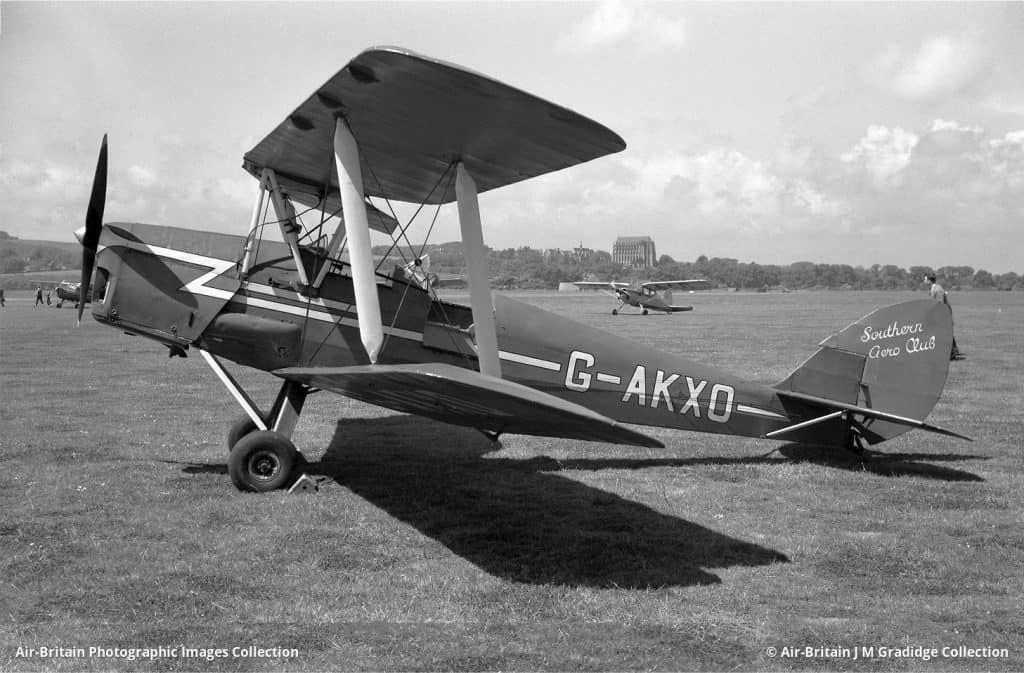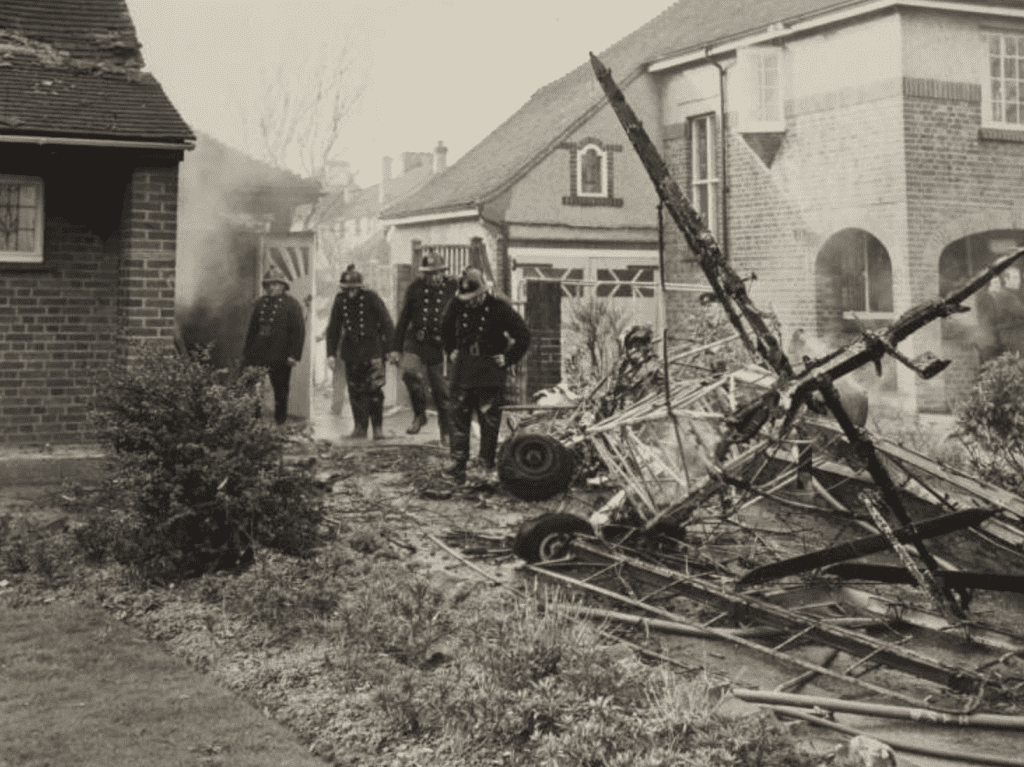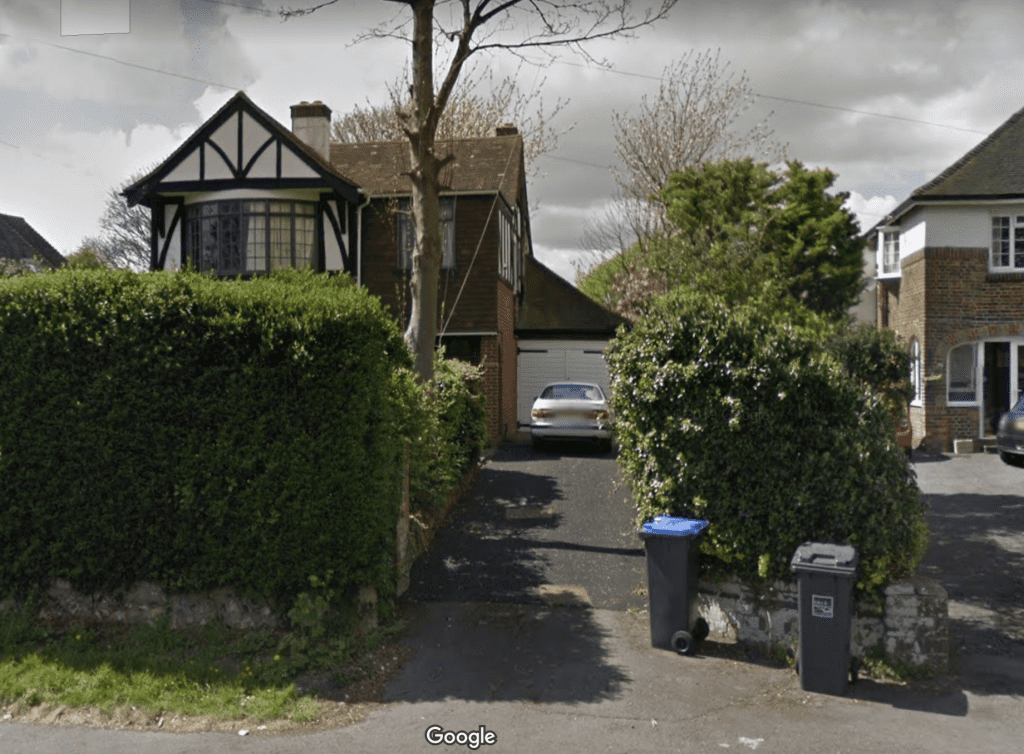Friday 13th March 1964: A light aircraft recently departed from Shoreham Airport crashed into a tree and the front garden of a house, 77 Buckingham Road, Shoreham. Both occupants of the Tiger Moth aircraft died either at the scene or en route to nearby Southlands Hospital. The deceased were pilot, Colin Barrett (23) of Hove and passenger Harold Ginn (33) of Brighton.



The subsequent Air Investigation Board report found that the aircraft was operating correctly at the time of the accident. Their conclusion was, in part, that the accident was caused by pilot error with alcohol possibly being a factor. However a witness who was not at the inquiry has recalled 60 years later that the aircraft was plummeting with smoke issuing from the engine and excessive noise. This gives a different view on the probable cause of the stall and resulting crash.
Local resident Christopher Kenneford witnessed the crash from the corner of Nicholson Drive.. less than a 100 yards away:
It was just another normal Friday afternoon for me, a 7-year-old schoolboy as, lessons over, I left St. Peter’s primary in Sullington Way with one of my classmates on our usual homeward trek back towards the town – a distance of maybe three-quarters of a mile (different times then, so no flotilla of cars outside the school gates gathering up young offspring). A right turn at the bottom of the cul de sac, across Eastern Avenue and then onto the path that led down through the allotments and the agricultural smallholdings beyond. After the usual dawdling over the livestock in a part of the area that we colloquially knew as “Piggy Way” – and doubtless some general schoolboy mucking about – we eventually reached the junction of Buckingham Road and what is now Nicholson Drive. Suddenly, a loud drone out of nowhere – much louder than the usual buzzings of light aircraft into and out of the airport – and we turned to look over our right shoulders. Unbelievably, a bi-plane coming down through the trees, hardly any distance away, smoke from the engine, two people on board. Seconds later, a noise like an explosion, then flames as the plane ended its journey half a dozen houses along on the other side of the road from where my friend and I stood…. A terrifying sight for a small boy and I ran the rest of the way home, breathlessly recounting what I’d seen to family members assembled around the kitchen table. When I returned with them to the scene of the accident a short while later, a crowd had gathered, and the emergency services were fighting to control the situation. I remember an ambulance standing there, its rear door open, its mission fruitless. Miraculously though, the owners of the house in question had moved out earlier the same day, en route to a new life in Australia. A few hours later and schoolwork done, their small children might have been playing in the front garden.
Christopher Kenneford 2022
Official Witness Statement 1
“On Friday 13th March 1964, I was standing on the high ground half way along Willmott Road I saw the Tiger Moth climbing away in my general direction after taking off from the aerodrome. I estimate that it was just about over Buckingham Road when it did an aerobatic sort of turn to the left. It appeared to do about one turn of a spiral dive then level out pointing towards the north, and almost immediately the nose dropped, the engine noise cut out and a cloud of smoke came from the front of the aeroplane, and it went into another spiral dive also to the left and completed one and a bit turns then dived down in a direction heading towards the aerodrome. From where I was watching it looked like a vertical dive because I was directly in line with it facing the west. In my opinion it never recovered from this dive but carried on straight into the house.
I did not see it hit the house as it was out of my vision, in any case I was so certain that it was going to crash that I was already on my bike heading for the aerodrome. I did see the plume of smoke come up just after the aeroplane went out of my sight. I cycled around to Buckingham Road first of all and then over to the aerodrome. After the engine noise cut out I did not hear it come on again. I am reasonably certain that it did not start up again. I did not notice whether the propeller had stopped rotating or not it was a bit too far from me for me to distinguish it. I did not see anything fall from the aeroplane while it was in my sight. There was definitely one other aeroplane and probably another around at the time. ”
R. Tugnett 1964
Official Witness Statement 2
C. L. Pashley, Chief Flying Instructor of Southern Aero Club Ltd. Shoreham Airport
“Mr. Colin Barrett had completed a pilots course with the club and had obtained his Private Pilots Licence. I produce herewith his training record with the club, as far as I know his flying log book would be in his own possession. In my opinion he was a good average pilot. I have had to reprimand him for wanting to fly in unsuitable weather on several occasions. Regarding his flying discipline – when he flew with me his discipline was quite correct, but because I did have some suspicions I did from time to time give him a pep talk. Like many Eastern pupils he did have a conceited tendency. He has had no previous accidents or incidents with us. As far as Mr. Ginn was concerned he was a pupil pilot and was getting close to the qualifying stage. He was flying as a passenger in the aircraft and would have been in the front passenger seat. The control column from the front had been removed in accordance with the club rule.
I authorised Barrett for this flight and agreed Mr. Ginn going only as passenger. I told Barrett that he couldn’t have the aircraft for long as I wanted it for another dual flight, he said he was only going to do a few circuits. The weather at the time was perfect. I did not see the aircraft flying as I was flying in another aircraft at the same time. With regard to the possibility of the aircraft having got into a spin, part of the take-off drill is to unlock the slots. With the slots free the Tiger Moth is very unlikely to spin inadvertently; it is far more likely to go into a semi-controlled spiral.
One can only surmise that the aircraft may have got into a semi-controlled spiral and because of some form of panic the pilot was unable to regain control. The pilot after all was not by normal standards very experienced. The aircraft had flown on two occasions earlier in the day, and I had myself been flying it, there was as far as I was concerned nothing wrong with the aircraft at all. I produce herewith the Certificate of Registration, the engine and airframe log books for G-AKXO.”
C. L. Pashley 1964


I was a 14 year old school boy who travelled by train from school to Shoreham, On the late Friday after non I was walking up Buckingham road at approximately500 metre away I saw the aircraft heading south down the Buckingham road I think an attempted landing was underway. The aircraft verred wing up and crashed in the house above the front door. Within minutes nothing was left of aircraft. I noticed the tree outside the drive way
of the house had been tripped back almost as if a knife had sliced it away. but probably one of the Port wings had done this damage
I remember this tragic event as I was returning by train as a 15 year old to Shoreham from Worthing High School for Girls. I believe the plane came down next to a house in Buckingham Road where a boy called Alan Field lived. I had gone to Victoria Road Primary School with him.
This is the first time I have looked at this web site and analysis/observations of this crash. I am currently visiting Shoreham and was walking past 77 Buckingham Road and recalling the tragic Tiger Moth crash that I witnessed in 1964. Hence my visit to this site. At the time I was 11 years old and was with some other lads at the bottom end of Buckingham Park. My recollection of the events before the actual crash differ somewhat from others reported here. The plane’s engine spluttered a few times as it was coming in heading west at what seemed to me to be a lower than usual altitude compared with many other aircraft I had seen approaching Shoreham airfield over the years. The plane was in level fight when the engine spluttered, ‘coughed’ produced one or two puffs of smoke and then cut out. I watched it fall out of sight behind the trees – then a big plume of smoke appeared as I ran towards the crash site on Buckingham Road. I witnessed the fire and the recovery of the bodies. My observation and opinion is that the plane lost what altitude it had after the engine cut out. It was not producing much smoke prior to the crash other than the puffs as the engine coughed and spluttered.
Steve, thanks for your recounting of the incident. That detail tallies with Christopher Kenneford’s recent recollection which prompted my conclusion that if there was smoke issuing from the engine that it was unlikely to be pilot error as the principal cause of the accident.
Thank you for your prompt reply. I guess I am a little concerned that there is an inference in some statements that the engine might have been on fire prior to the crash. My observation did not support this inference. To me it sounded very like an engine starved of fuel as it coughed and splittered and finally cut out. The smoke that was visible prior to the crash appeared to be the sort you get from an engine trying to fire/start/ get going. Why the aircraft was so low prior to the crash is a mystery to me. As before – I had never seen one come in that low on what I presume was an approach. Regards Steve.
I did not see any fire from the engine prior to the crash – only some plumes of smoke. This also tallies with the statement issued by the witness in Willmott Road about smoke being observed issuing from the front of the aircraft.